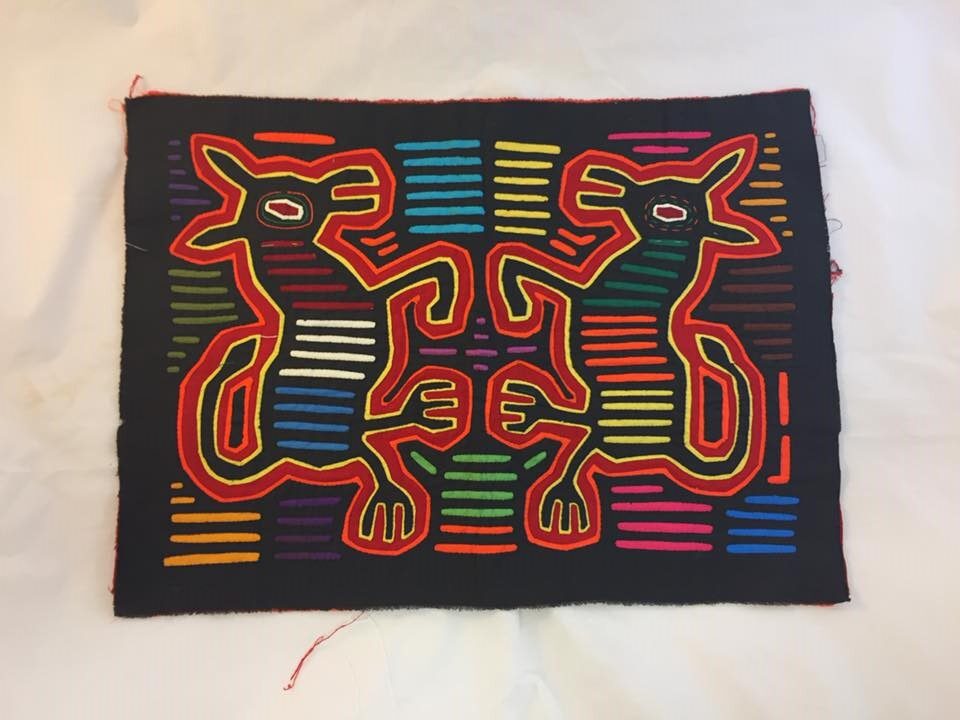Molas are colorful, hand-sewn textiles that are produced by the female artisans of the Kuna culture of the San Blas region of Panama. The earliest molas are said to have developed after the arrival of Spanish missionaries in Central America, when women were encouraged to cover their bare upper torsos. In response, the Kuna women created blouses made of imported cotton cloth and thread. Earlier molas were covered with geometric motifs that are believed to mimic traditional body painting designs; these developed into textiles using several layers of cloth and the complex, reverse appliqué method that cuts through the layers and turns them outward, creating elaborate, multicolored designs. In the 20th century, the Kuna also began adding additional appliqué and embroidery, making even more complex designs.
In 1925, the Kuna prevailed in a revolution against the Panama government, which was trying to “modernize” their culture. Since that time, they have actively cultivated their traditions and passed them on to their children. 20th and 21st century molas are perhaps unusual among traditional artforms of the Americas in their wide and ever-changing variety of subjects and motifs. The most popular mola designs include birds, fish, animals, flowers, and plants, but artisans also incorporate images from everyday life, including commercial logos, buildings, boats, vehicles, and household objects. Today Kuna women often belong to a “mola cooperative,” which acts much like a labor union, and they make molas on commission.
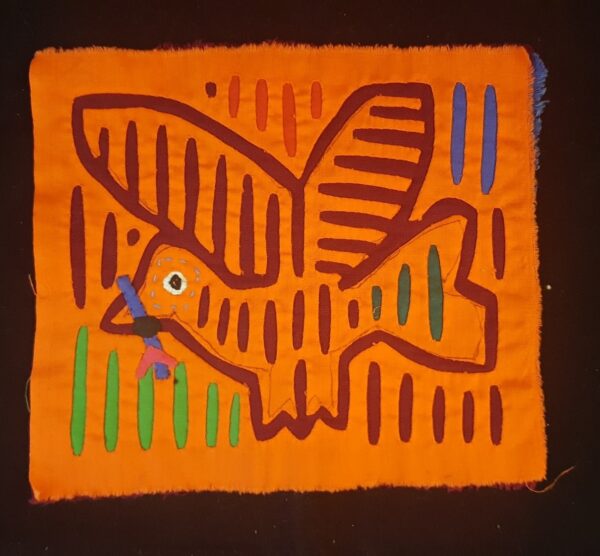
Kuna culture
20th century
Cotton cloth, thread, and pigment, L. 19 cm x W. 2 mm x H. 17 cm
BFPC collection #2014.31
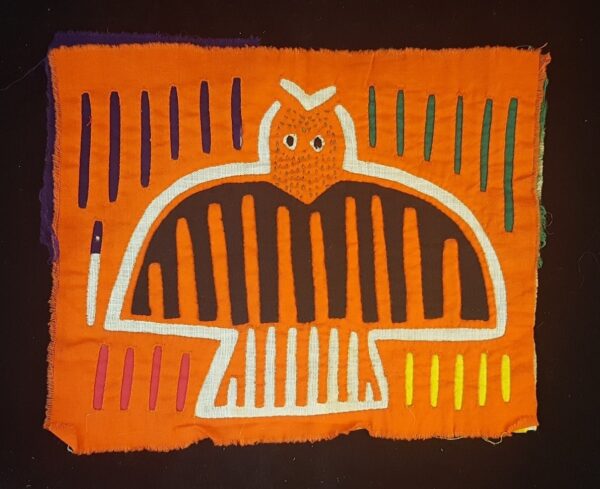
Kuna culture
20th century
Cotton cloth, thread, and pigment, L. 21.5 cm x W. 3 mm x H. 17.5 cm
BFPC collection #2015.1a
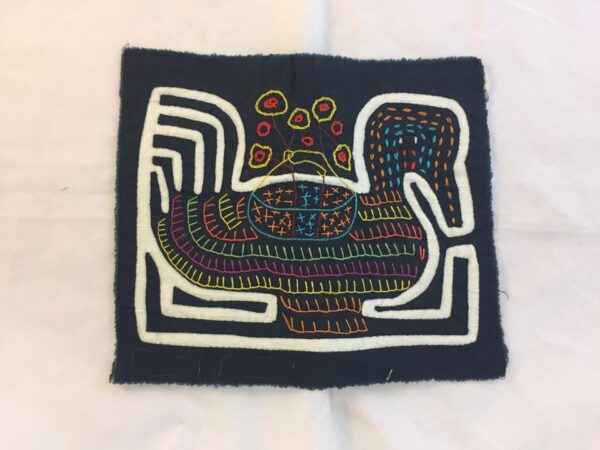
Kuna culture
20th century
Cotton cloth, thread, and pigment, L. 22.1 cm x W. 2 mm x H. 8.5 cm
BFPC collection #2014.28
Young girls are trained first to make molitas, or small molas, with the traditional oval or lozenge-shaped reverse-appliqué forms that are called tas-tas. Since the late 20th century, girls are also taught to incorporate appliqué and embroidery to provide more color to their designs. The molitas are used as samples, to show the girls’ increasing skill, as well as being items to be sold as souvenirs in the tourist trade. The girls thus begin at an early age to assume the important role in their communities of making money to support their families and their cultural traditions. Molitas and other small sections of reverse-appliqué may also be used as decorative accent panels on other types of clothing, and they are used to decorate a wide variety of non-traditional, tourist-trade objects such as shoes and eyeglasses cases. Researched by Codee Ratliff and Elizabeth Ferguson
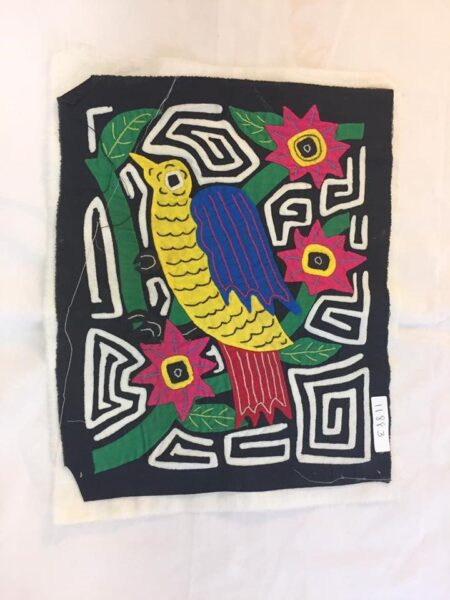
Kuna culture
20th century
Cotton cloth, thread, and pigment, L. 48.8 cm x W. 2 mm x H. 40.8 cm
BFPC collection #2011.6
This mola is unusual in a number of ways. First, it is of a size in between a molita and a full-size mola. Next, the main design, a yellow bird sitting on flowering branches, is made completely of appliqué with embroidered details, rather than of reverse appliqué. Finally, the background areas are filled with oddly shaped, geometric reverse appliqué designs, rather than the lozenge-shaped designs usually used in figural molas. All together, this suggests that this mola was made by a young woman who was learning the craft, rather than by a master mola artisan. Researched by Elizabeth Ferguson
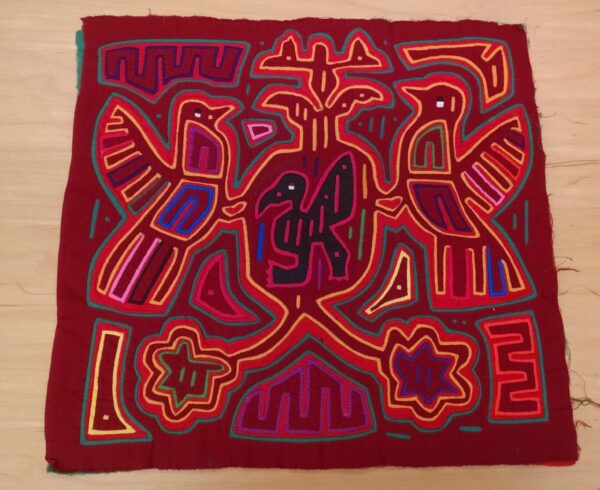
Kuna culture
20th century
Cotton cloth, thread, and pigment, L. 43.5 cm x W. 2.5 mm x H. 41.5 cm
BFPC collection #2016.5
Kuna women make pairs of similar but not identical, full-size molas, one to wear on the front of their blouses and one to wear on the back. To “wear mola,” which also implies dressing fully in Kuna attire, is seen as an expression of pride in Kuna culture and as making a visual statement about supporting their traditions. The large size of this mola and the traditional motifs of birds and vegetation closely resemble the molas typically worn by Kuna women. While it is common for Kuna artisans to “recycle” molas by cutting them from old blouses and selling them, they also make new molas and other articles decorated with reverse appliqué for the tourist trade. The pristine nature of this mola, therefore, suggests that it was not worn as part of a blouse, but sold as new. Researched by Tana Redman
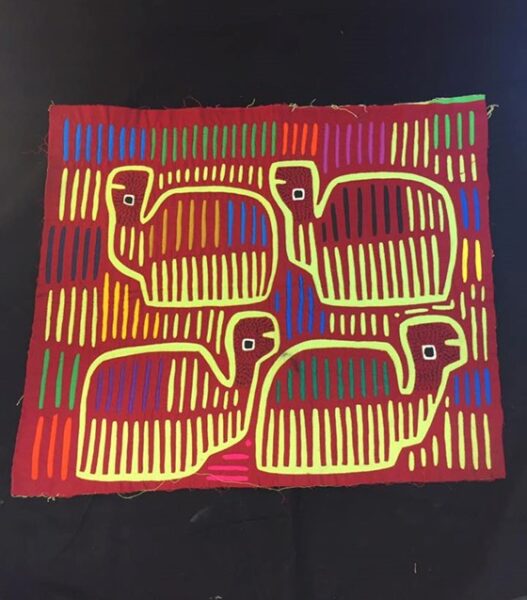
Kuna culture
20th century
Cotton cloth, thread, and pigment, L. 48.8 cm x W. 2 mm x H. 40.8 cm
BFPC collection #2011.6
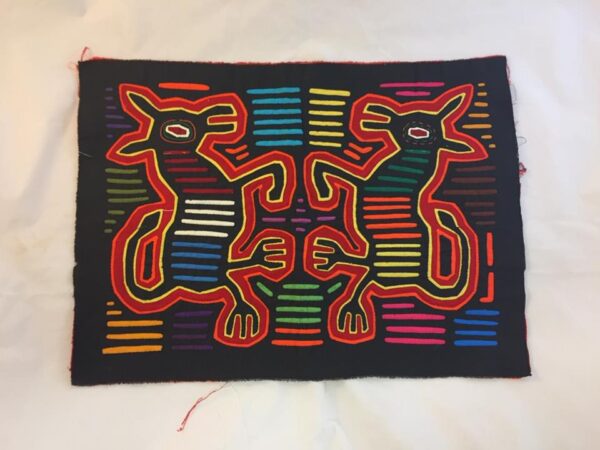
Kuna culture
20th century
Cotton cloth, thread, and pigment, L. 48.8 cm x W. 2 mm x H. 36 cm
BFPC collection #2016.4
These two molas are highly traditional, both in their motifs of animals common to the San Blas region and in their use of the traditional, colorful, lozenge-shaped reverse-appliqué forms that fill the spaces inside and outside of the animal forms. The Mola with Four Light Green Turtles illustrates two pairs of turtles arranged traditionally as mirror images, but one above the other, while the Mola with Two Dogs on a Black Background shows the two images as if one dog were standing on its hind legs in front of a mirror. Although they use traditional motifs and arrangements, however, like the Mola with Two Red Birds and Small Black Bird, these molas are in new condition, with no signs of having been part of a blouse, and they were likely made to be sold directly in the tourist trade. Researched by Elizabeth Ferguson
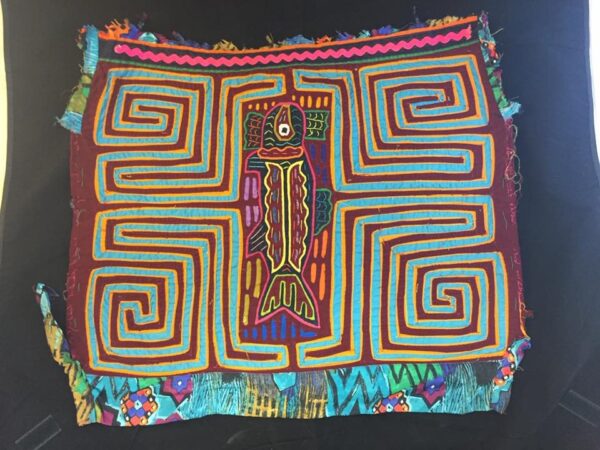
Kuna culture
20th century
Cotton cloth, thread, and pigment, L. 50.5 cm x W. 4 mm x H. 46.2 cm
BFPC collection #2011.5
This complex mola depicts an elaborate, multicolored fish motif that is framed with traditional lozenge-shaped background designs, all set within a labyrinth-like geometric design that is mirrored on each side. In addition to several layers of reverse-appliqué in both the fish and the geometric design, the fish also incorporates layers of added appliqué and embroidery. This mola was not so unusual that it would have been considered inauthentic or inappropriate, however, as the signs of wear and the remnants of printed fabric around the edges clearly indicate that this is a “recycled” mola – in other words, that it was incorporated into a Kuna woman’s blouse and worn for some time before it was cut out and sold on the tourist trade. Researched by Elizabeth Ferguson
For more information, you may contact the researcher(s) noted in the title of this exhibit entry, or Dr. Billie Follensbee, the professor of the course, at BillieFollensbee@MissouriState.edu

